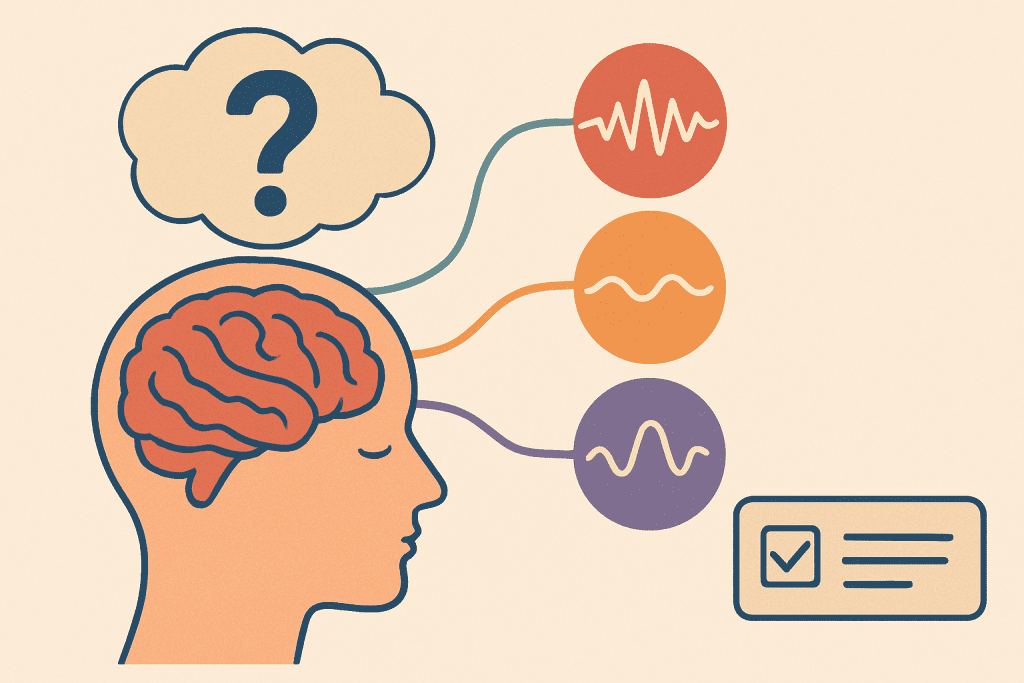
Brainwave entrainment is becoming increasingly popular for relaxation, focus, and even sleep improvement. But here’s the kicker your results depend heavily on the headphones you use. Why? Because entrainment relies on how your brain perceives subtle frequency differences between your ears. External auditory stimulation at a specific frequency can cause your brain’s electrical activity to oscillate at the same frequency, which is the foundation of brainwave entrainment. Without the right headphones, the effect may be weak or nonexistent. So, let’s dive into the world of headphones and figure out which ones are best for brainwave entrainment.
Understanding Brainwave Entrainment
Brainwave entrainment works by using rhythmic auditory (or visual) stimuli to nudge your brainwaves electrical oscillations in the brain associated with different mental states into specific frequency ranges. For example:
- Alpha waves (8–12 Hz): Relaxed but alert, great for creativity
- Beta waves (13–30 Hz): Focus and problem-solving
- Theta waves (4–7 Hz): Deep relaxation, meditation, light sleep
- Delta waves (0.5–3 Hz): Deep sleep and recovery
- Gamma waves (30–100 Hz): High-level learning, memory, consciousness
Brainwave entrainment targets specific frequencies that correspond to these brainwave states, allowing you to achieve desired mental states like relaxation or heightened focus. This works because of the way the brain works responding to these frequencies by altering brain activity, which can influence mood, cognitive function, and overall mental well-being.
Listening to binaural beats or isochronic tones in these ranges can enhance relaxation, boost focus, or help you fall asleep faster. But only if your headphones deliver the sound accurately.
Types of Entrainment
Brainwave entrainment isn’t a one-size-fits-all approach there are several methods, each with its own unique way of guiding your brainwaves into a desired state. The most popular techniques include binaural beats, monaural beats, isochronic tones, and audio visual entrainment.
Binaural beats work by playing two slightly different frequencies in each ear. Your brain perceives a third, “phantom” beat the difference between the two frequencies which can help shift your brainwave activity into a specific state, like relaxation or focus. This method requires stereo headphones to deliver the different frequencies to each ear.
Monaural beats use a single speaker to combine two frequencies into one pulsing sound. Unlike binaural beats, you don’t need headphones, as the pulsing effect is created in the air before reaching your ears. This makes monaural beats a convenient option for group sessions or when headphones aren’t practical.
Isochronic tones are single tones that pulse on and off at regular intervals, creating a rhythmic effect that’s easy for the brain to follow. These tones are highly effective for entrainment because the clear, repetitive pulsing sound can quickly synchronize brainwave activity, even without headphones.
Audio visual entrainment takes things a step further by combining sound with visual stimuli, such as flickering lights or pulsing colors. This multi-sensory approach can enhance the entrainment effect, making it easier to reach meditative or focused brainwave states.
Each method uses different frequencies and types of stimuli to help you achieve your desired brainwave state, whether that’s deep meditation, improved focus, or restful sleep.
Audio Visual Entrainment vs. Audio Entrainment
When it comes to brainwave entrainment, you have the option of using just sound (audio entrainment) or combining sound with visual stimuli (audio visual entrainment, or AVE). Both methods aim to guide your brainwaves into specific patterns, but they do so in slightly different ways.
Audio entrainment relies solely on sound like binaural beats, monaural beats, or isochronic tones to influence your brainwave activity. This method is simple, easy to use, and effective for many people, especially when you want to relax, meditate, or boost focus using just your headphones.
Audio visual entrainment (AVE), on the other hand, adds another layer by incorporating visual stimuli, such as flickering lights or pulsing colors, along with sound. By engaging both your auditory and visual senses, AVE can produce a more powerful effect on your brainwave patterns. This multi-sensory approach can help you reach deeper states of relaxation or heightened focus more quickly and effectively than audio alone.
While AVE can be more immersive and potent, some people prefer the simplicity and convenience of audio entrainment, especially for everyday use or when on the go. Ultimately, the best choice depends on your personal preferences and goals for brainwave entrainment.
The Role of the Auditory Cortex in Brain Wave Activity
The auditory cortex is a key player in how your brain responds to sound-based entrainment methods like binaural beats and isochronic tones. When sound waves enter your ears, they’re processed by the auditory cortex a region of the brain responsible for interpreting the frequency, rhythm, and patterns of sound.
This processing is crucial for brainwave entrainment. The auditory cortex detects the subtle differences in frequency between the sounds played in each ear (as with binaural beats) or the rhythmic pulsing of isochronic tones. It then sends signals to other parts of the brain, helping to synchronize your brainwave patterns with the external sound.
This phenomenon, known as the frequency following response, allows your brainwaves to align with the frequency of the entrainment audio, leading to changes in brainwave activity. Whether you’re aiming for relaxation, focus, or a meditative state, the auditory cortex is at the heart of how your brain responds to these entrainment techniques.
Why Headphones Are Important
Not all headphones are created equal when it comes to brainwave entrainment. Here’s why they matter:
- Stereo separation: Essential for binaural beats, since each ear must receive slightly different frequencies. For example, one frequency is delivered to the left ear and a different frequency to the right ear, which is necessary to create the desired entrainment effect.
- Comfort: Entrainment sessions can last 30 minutes to an hour. Uncomfortable headphones = distraction.
- Frequency response: You need clean, distortion-free sound across the full range.
Think of headphones as the “vehicle” delivering the entrainment signal. A poor vehicle ruins the ride.
Types of Headphones for Brainwave Entrainment
Let’s break down your options:
- Over-ear headphones – Big cushions that fully cover your ears.
- On-ear headphones – Rest on your ears but don’t enclose them fully.
- In-ear headphones (earbuds) – Compact, portable, and fit inside your ear canal.
- Bone conduction headphones – Transmit sound through your cheekbones.
Each has strengths and weaknesses depending on how you plan to use them.
Over-Ear Headphones
Pros:
Great sound quality and stereo separation
Excellent for immersive experiences
Comfortable with cushioned earcups
Cons:
- Bulky for travel
- Can get hot during long sessions
Best for: Home meditation sessions, deep focus work, and anyone who prioritizes comfort.
On-Ear Headphones
Pros:
- Lighter and more portable than over-ear
- Still provide decent sound quality
Cons:
- Less comfortable for long sessions
- Can leak sound and let in noise
Best for: Short entrainment sessions, casual listening, or when you don’t want bulky headphones.
In-Ear Headphones (Earbuds)
Pros:
- Compact, lightweight, and portable
- Good sound isolation (especially with silicone tips)
- Affordable options available
Cons:
- Not always comfortable for long use
- Smaller drivers may limit bass response
Best for: On-the-go entrainment, travel, or discreet listening.
Bone Conduction Headphones
How they work: Instead of sending sound through your eardrum, they transmit vibrations directly through your cheekbones.
Pros:
- Keep ears open, so you can stay aware of surroundings
- Comfortable for people who dislike earbuds or earcups
Cons:
- Lower sound fidelity compared to traditional headphones
- May not produce the strong stereo separation needed for binaural beats
Best for: Outdoor meditation walks or people with hearing sensitivities.
Wired vs Wireless for Brainwave Entrainment
- Wired headphones: Zero latency, no battery worries, reliable for consistent entrainment.
- Wireless headphones: Freedom of movement, fewer cables to deal with.
Verdict: If you’re serious about entrainment sessions, wired headphones give more accuracy. But if comfort and convenience are priorities, wireless works fine.
Noise-Canceling Technology
Do you need noise-canceling? Not always.
- Helps when: You live in a noisy environment and want to focus.
- Drawbacks: Active noise canceling can slightly alter audio frequencies, but usually not enough to ruin entrainment.
If peace and quiet are essential for you, noise-canceling headphones are worth it.
Comfort and Fit Considerations
Imagine sitting through a 45-minute session with headphones pressing too hard on your ears. Nightmare, right?
Look for:
- Soft padding and breathable materials
- Adjustable headbands
- Lightweight design
Comfort is not just luxury it’s essential for focus.
Sound Quality and Frequency Response
For brainwave entrainment, you don’t need audiophile-grade headphones. What you do need is:
- Balanced frequency response (no overpowering bass or sharp treble), with the ability to accurately reproduce the full frequency range required for brainwave entrainment
- Clean stereo imaging
- Minimal distortion, even at low volumes
A flat, accurate sound profile ensures your brain receives the tones correctly.
Risks and Limitations of Brainwave Entrainment with Headphones
While brainwave entrainment with headphones is generally considered a safe and noninvasive method for most people, there are some important risks and limitations to keep in mind. Individuals with a history of seizures or epilepsy should avoid using brainwave entrainment, especially when it involves flashing lights or pulsing sounds, as these can potentially trigger seizures.
People with certain medical devices, such as pacemakers or implantable cardioverter-defibrillators, should consult their healthcare provider before trying brainwave entrainment, as the effects of rhythmic sounds on these devices are not fully understood. It’s also wise to start with short sessions and gradually increase the duration, allowing your body and brain to adjust to the new stimuli.
Always follow recommended guidelines and listen to your body if you experience discomfort, dizziness, or any unusual symptoms, stop the session immediately. As with any wellness practice, safety comes first.
Budget-Friendly vs Premium Headphones
Do you need to drop $500 on fancy headphones? Absolutely not.
- Budget options: Great if you’re just starting out. Many earbuds and mid-range over-ears work fine.
- Premium options: Worth it if you want maximum comfort, durability, and pristine sound quality.
The sweet spot is mid-range quality sound without breaking the bank.
Top Recommended Headphones for Brainwave Entrainment
Here are some solid choices (no affiliate links, just straight recommendations):
- Best Over-Ear: Audio-Technica ATH-M50x – Balanced sound, comfortable, reliable.
- Best In-Ear: Shure SE215 – Excellent isolation, clear audio.
- Best Wireless: Sony WH-1000XM5 – Top-tier noise cancellation, immersive sound.
- Best Bone Conduction: AfterShokz Aeropex – Lightweight and keeps you aware of surroundings.
Future Research and Development in Brainwave Entrainment Technology
The future of brainwave entrainment is bright, with ongoing research and development aimed at making these techniques even more effective and accessible. One exciting area is the advancement of audio visual entrainment systems that can be personalized to match your unique brainwave patterns and goals, offering a more tailored approach to relaxation, focus, or meditation.
Researchers are also exploring the use of transcranial magnetic stimulation (TMS) and transcranial direct current stimulation (tDCS) to enhance the effects of traditional entrainment methods. These noninvasive technologies use magnetic or electrical fields to influence brainwave activity, potentially offering new ways to support cognitive enhancement and well-being.
Additionally, integrating brainwave entrainment with other therapies such as meditation, cognitive training, or even treatments for neurodegenerative disorders could lead to more comprehensive and effective solutions for mental health and brain function. As our understanding of brainwave patterns and neural entrainment grows, we can look forward to more sophisticated, personalized, and powerful brainwave entrainment technologies in the years ahead.
Tips for Getting the Most Out of Brainwave Entrainment
- Keep the volume low to moderate. Too loud can strain your ears and ruin the effect.
- Stick to 20–45 minutes per session. Enough time for your brain to sync.
- Create a distraction-free environment. Dim lights, silence notifications, and get comfortable. Minimizing external stimuli helps your brain focus on the entrainment audio and enhances the effect.
Entrainment is like training a muscle the more consistent you are, the stronger the results.
Conclusion
The best headphones for brainwave entrainment are the ones that balance comfort, clarity, and stereo separation. Over-ear models are fantastic for home use, earbuds are perfect for travel, and bone conduction has its niche for outdoor sessions. The key is finding headphones that let you relax and stay immersed without distraction. Invest in a pair that feels good, sounds good, and fits your lifestyle and your entrainment practice will thrive.
FAQs
Yes, as long as they provide stereo separation and decent sound quality.
Not required, but helpful if you’re in a noisy environment.
Yes, though wired headphones give slightly more accuracy.
Keep it at a comfortable, moderate volume. Too loud can reduce effectiveness.
Over-ears usually offer better comfort and sound, but earbuds work well for travel and portability.
Binaural beats are created by playing two tones of slightly different frequencies, one in each ear. The brain processes these two tones and perceives a third tone, which is an auditory illusion known as the third tone. This third tone is not a physical sound but a perceptual effect resulting from neural processing in the auditory pathway.




